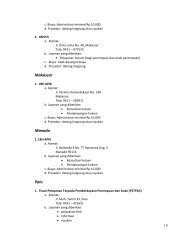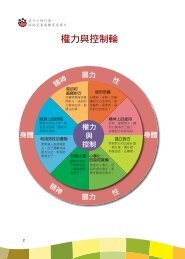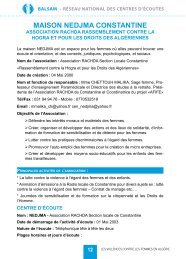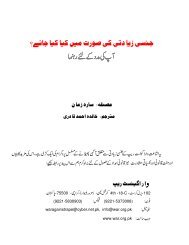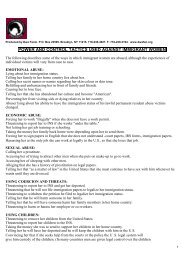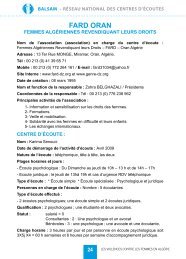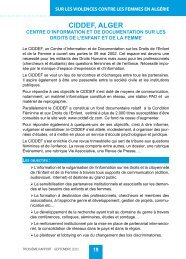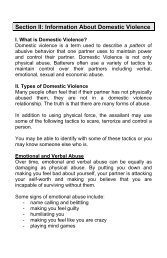Working with Battered Women: a Handbook for ... - Hot Peach Pages
Working with Battered Women: a Handbook for ... - Hot Peach Pages
Working with Battered Women: a Handbook for ... - Hot Peach Pages
Create successful ePaper yourself
Turn your PDF publications into a flip-book with our unique Google optimized e-Paper software.
The Cycle Of ViolencePhase One: Tension Building StateHe attacks her verbally <strong>with</strong> insults, put-downs, accusations. Minor battering incidents occur.She tries to calm him, trying to anticipate his every whim. As tension builds, she becomesmore passive, he becomes more oppressive. She blames herself <strong>for</strong> not being able to controlthe situation. Nothing she tries works and a feeling of hopelessness begins to grow <strong>with</strong>inher. The tension becomes unbearable.Phase Two: Acute Battering IncidentTensions that build up in Phase One erupt in violence. The incident is usually triggered by anexternal event or by the internal state of the man, rather then by the woman's behaviour. It isduring this stage that the woman is most likely to be sexually assaulted, physically injured, orkilled.Phase Three: Honeymoon StageAfter the acute battering incident, the man becomes extremely loving, kind and contrite. Hetells her that it happened because he had a bad day at work or had too much to drink. Hebegs <strong>for</strong>giveness and promises it will never happen again. He tells her that he still loves herand needs her more than ever. For a time he becomes the perfect husband, father, lover,friend. As their relationship deteriorates, his loving behaviour is increasingly important toher. For a time he seems like the man she fell in love <strong>with</strong>. The "Honeymoon" stage alsocauses the woman to doubt the abuse ever took place, or if it did, to think that she caused it.The purpose is to invalidate the memory of the abuse.Guilt also holds her. They both believe she is responsible <strong>for</strong> his future welfare, or, if sheleaves, <strong>for</strong> breaking up the home. However, if she stays, it is not long be<strong>for</strong>e the lovingbehaviour gives way to small battering incidents, and a new cycle of violence begins.Over time, the cycle of violence shifts. Honeymoon periods become shorter; denial, tensionand violence increase. Eventually the couple only experiences affection and tendernessduring a honeymoon stage, after a beating. The absence of other closeness in their livesmakes them increasingly desperate and hopeful during the honeymoon phase, especially asthe time period becomes shorter and the violence increases. The cycle becomes a trap—thereis hope during the quiet periods that it will end, but it doesn’t end.9



